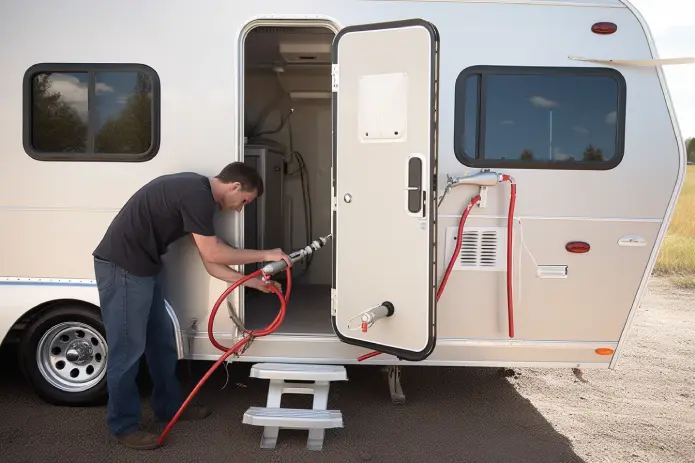Last Updated on December 24, 2023
Having hot water on the road is essential for RVers for a comfortable travel experience. But what if you’re tired of taking cold showers or want to cut down on propane expenses? The solution is simple: bypass the RV’s hot water heater.
To bypass an RV hot water heater, you must locate the hot water heater first. Turn off the water supply to the RV water heater. Next, look for a bypass valve near your hot water heater or in a bypass kit. Ensure that the bypass valve(s) are positioned appropriately by rotating the valve(s).
Today we’ll discuss in detail the steps you need to follow to successfully bypass your RV hot water heater. So, let’s get started with the in-depth discussion.
How to Bypass Hot Water Heater in RV: Step-by-Step Guides
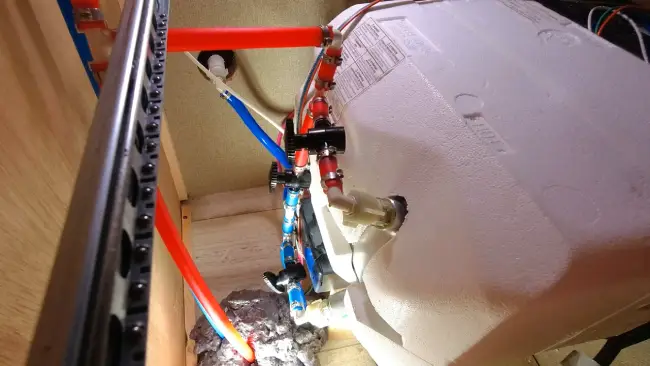
STEP 1. Locate the Hot Water Heater
STEP 2. Shut Off the Water Supply
STEP 4. Adjust the Bypass Valve
If you need to bypass hot water heater in your RV, you must follow some proper steps:
STEP 1. Locate the Hot Water Heater
You’ll need to find the access panel where the device (that warms up the water in your RV) is located. Depending on your RV model, the hot water heater may be located on the exterior or interior of the vehicle.
If it’s on the exterior, it’s usually behind a small door that can be opened by pulling down on a latch. Conversely, it might be hidden behind a removable panel or cabinet if it’s on the interior.
STEP 2. Shut Off the Water Supply
Now it’s time to prevent any potential plumbing damage by turning off the water supply valves connected to the hot water heater in your RV. These valves are usually labeled and can be found near the heater itself.
Locate the cold water inlet and hot water outlet valves and close them. This will prevent any new water from entering or leaving the heater, allowing you to bypass it without causing any issues.
STEP 3. Find the Bypass Valve
Next, you’ll need to locate the bypass valve. This valve allows water to flow around the device that provides hot water and is essential when winterizing your RV or when you need to bypass the RV hot water heater for some reason.
Look for a bypass kit or valve near the hot water heater to find the bypass valve. Once you locate the valve, turn it to redirect the water around the heater. This will allow you to continue using your RV’s water system without hot water.
STEP 4. Adjust the Bypass Valve
Once you’ve found the bypass valve, the next step is to adjust it properly. To bypass the RV hot water heater in your RV, rotate the bypass valve(s) to the appropriate position.
Make sure that you close the valve between the cold water inlet and the hot water outlet while opening the valve. Refer to your RV’s manual for specific instructions on the bypass valve positions as they may vary.
STEP 5. Test the Water Flow
After adjusting the bypass valve, it’s time to test the water flow in your RV. Turn on the water supply and go around to check if water is flowing properly through the faucets and shower without going through the hot water heater.
If you notice any issues with water flow, turn off the water supply and double-check the valve positions.
Ensure the hot water valve is fully closed, the cold water valve is fully open, and the bypass valve is set to bypass the hot water heater. The bypass system routes cold water to the hot water plumbing line instead of the water heater.
How does a water heater bypass valve work?
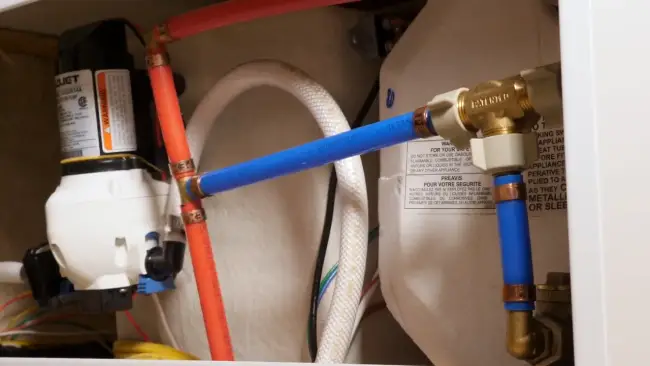
Bypass valves block cold water flow into the water heater, passing it to the hot water lines. This is useful when you want to conserve propane and electricity or when you need to perform maintenance on your water heater.
In bypass mode, the valves on the lines going into the water heater are closed, and the crossover line valve is opened to redirect the water flow to the hot water lines.
This allows the hot water to flow freely without being heated by the water heater. Doing this ensures that your hot water is always at the desired temperature, even when not using the water heater.
Complex panels can bypass the water heater, but they come with more plumbing lines, valves, and the potential for leaks. To avoid these complications, you can use a simple bypass valve that’s easy to install and maintain. With this valve, you can control the temperature of your hot water and save on energy costs.
What happens when a bypass hot water heater valve fails in an RV?
If your bypass water heater valve fails in your RV, you may experience several issues that could impact the functioning of your water system.
#1 Inadequate Water Supply
When the bypass valve fails in the open position, it can prevent the water flow from passing through the hot water heater. Which can result in a significant reduction in or a complete lack of hot water supply in your RV.
This can make showering, washing dishes, and performing other hot water tasks a real struggle. You can bypass the hot water heater in your RV to ensure a continuous hot water flow.
It involves shutting off the water flow to the heater and redirecting it to the hot water line. Doing so can ensure a steady hot water supply and avoid the frustration of dealing with a faulty valve.
#2 Continuous Hot Water Flow
If you notice a continuous flow of hot water through your RV’s water heater, take action immediately. This can be caused by a failed bypass valve stuck in the closed position, leading to excessive heat buildup and potential damage to your water heater in the plumbing system.
To bypass the water heater in your RV, start by shutting off the water supply and disconnecting the inlet and outlet lines from the heater.
Then, connect the inlet and outlet lines together using a bypass kit or a simple piece of tubing. This will allow water to flow freely through the system without passing through the water heater.
#3 Pressure Imbalances
A failed or stuck bypass valve can cause issues such as reduced flow, leaks, or even damage to plumbing fixtures. These pressure imbalances can be frustrating and costly, but luckily, there are steps you can take to prevent and fix them.
One way to prevent pressure imbalances is to regularly inspect and maintain your RV’s water system, including the bypass valve. If you notice any issues or suspect a problem, it’s best to address them immediately to avoid further damage.
Also, follow any manufacturer guidelines for winterizing and de-winterizing your RV to prevent damage from freezing temperatures. By taking these steps, you can ensure that your RV’s water system is in good working order and avoid any unwanted pressure imbalances.
What are the Bypass Valve Configurations for Water Heater in an RV?
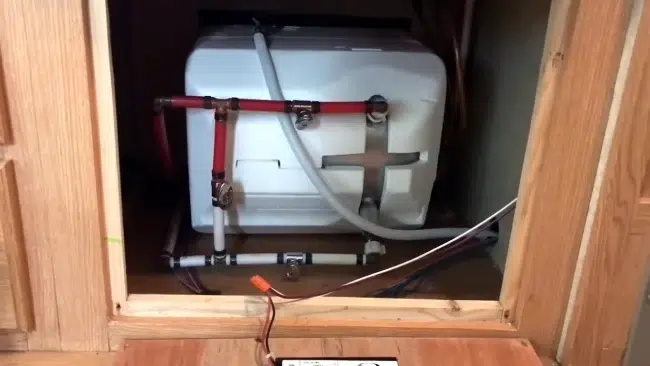
If you’re looking to understand the different configurations for bypass valves in your RV’s water heater, you’ll need to know about two valve systems and three-valve systems.
#1 Two Valve Systems
You’ll love how easy it is to control your RV’s water flow with a two-valve system. This configuration is the simplest of all the bypass valve options for your RV’s water heater. The two valves work together to regulate water flow into and out of the heater, making it easy to switch between normal and bypass modes.
In normal operating mode, the hot water heater is in use, and the two valves are opened to allow water to flow into the heater. When bypass mode is needed, simply close the two valves to stop the water flow into the heater and redirect it around the unit.
#2 Three Valve Systems
Get ready to upgrade your control over your RV’s water system with the three-valve system. This system includes three-way valves that allow you to switch between normal operating and bypass modes.
In the normal operating setting, the hot water flows through the water heater, while in the bypass mode, it’s directed around the water heater. The three-valve system is a great addition to your RV because it gives you more control over your hot water supply.
With this system, you can easily switch between the normal operating mode and the bypass mode, depending on your needs. Plus, it’s relatively easy to install and can save money on your energy bill.
Where is the RV water heater bypass valve located?
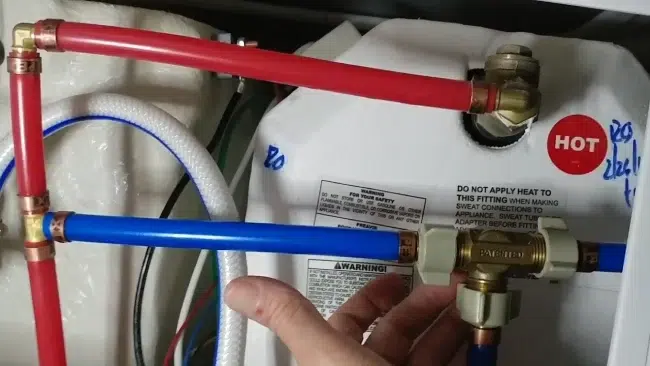
The valve is typically located inside or outside your RV at the back of the water heater. You’ll need to remove the large cover to access it, which may have a screen on the upper right-hand side.
Once you’ve located the water heater bypass valve, you’ll need to know how to use it. The valve allows you to bypass the water heater so that water can still flow through your RV’s plumbing system without being heated.
This is useful if you’re winterizing your RV or not planning on using hot water for a period of time. You can save on propane or electricity usage by bypassing the water heater.
How do I tell if the bypass valve is open or closed?
The handle on the bypass valve will tell you whether it’s open or closed. If the handle is perpendicular to the water line, the bypass valve is closed. When it’s parallel to the water line, the valve is open. It’s as simple as that.
When the bypass valve is closed, water will flow into the water heater tank, which means it will heat up and eventually provide hot water. When the valve is open, water will bypass the water heater tank so that it won’t get heated up and you’ll only receive cold water.
RV Water Heater Bypass Valves: Essential for Winter Maintenance and Cost Savings
Knowing RV water heater bypass valves is essential for maintaining your RV’s water system. Bypassing your hot water heater will protect it from damage during the winter season and save you money.
The process of bypassing is uncomplicated and can be achieved with minimal effort. The steps to bypass the hot water heater include locating the bypass valve, turning it to the bypass position, and checking the water flow before and after the process.
With this knowledge, you can confidently care for your RV’s water system. So, next time you head out on an RV adventure, correctly bypass your hot water heater.

